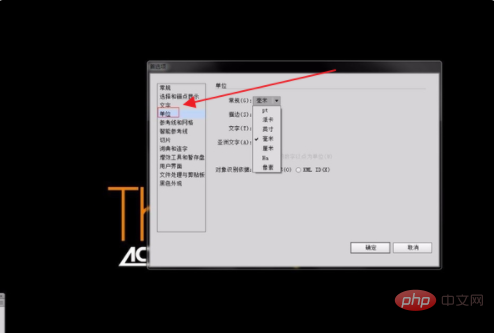How to change the size of ai
ai method to modify the size: first open the file and confirm the conversion unit as in; then press the shortcut key [CTRL k] to reset the unit; finally click [Confirm].

ai method to modify the size:
1. First open the file and see that the unit is in during transformation .

2. At this time, we usually want to change the unit to our commonly used mm or cm. Under normal circumstances, we will change the unit in the preferences (shortcut key CTRL k) to reset the units.

#3. After selecting the unit, click "Confirm" and then return to the file. We check the file size unit and it has been changed to the unit we selected.

#4. Another way to quickly change units is to open the file, bring up the ruler (shortcut key CTRL R), and right-click the ruler.

#5. We can see that there are many units to choose from. We select one of them and return to the file to see the size. The size has been changed.

The above is the detailed content of How to change the size of ai. For more information, please follow other related articles on the PHP Chinese website!

Hot AI Tools

Undresser.AI Undress
AI-powered app for creating realistic nude photos

AI Clothes Remover
Online AI tool for removing clothes from photos.

Undress AI Tool
Undress images for free

Clothoff.io
AI clothes remover

AI Hentai Generator
Generate AI Hentai for free.

Hot Article

Hot Tools

Notepad++7.3.1
Easy-to-use and free code editor

SublimeText3 Chinese version
Chinese version, very easy to use

Zend Studio 13.0.1
Powerful PHP integrated development environment

Dreamweaver CS6
Visual web development tools

SublimeText3 Mac version
God-level code editing software (SublimeText3)

Hot Topics
 How to output a countdown in C language
Apr 04, 2025 am 08:54 AM
How to output a countdown in C language
Apr 04, 2025 am 08:54 AM
How to output a countdown in C? Answer: Use loop statements. Steps: 1. Define the variable n and store the countdown number to output; 2. Use the while loop to continuously print n until n is less than 1; 3. In the loop body, print out the value of n; 4. At the end of the loop, subtract n by 1 to output the next smaller reciprocal.
 How to play picture sequences smoothly with CSS animation?
Apr 04, 2025 pm 05:57 PM
How to play picture sequences smoothly with CSS animation?
Apr 04, 2025 pm 05:57 PM
How to achieve the playback of pictures like videos? Many times, we need to implement similar video player functions, but the playback content is a sequence of images. direct...
 CS-Week 3
Apr 04, 2025 am 06:06 AM
CS-Week 3
Apr 04, 2025 am 06:06 AM
Algorithms are the set of instructions to solve problems, and their execution speed and memory usage vary. In programming, many algorithms are based on data search and sorting. This article will introduce several data retrieval and sorting algorithms. Linear search assumes that there is an array [20,500,10,5,100,1,50] and needs to find the number 50. The linear search algorithm checks each element in the array one by one until the target value is found or the complete array is traversed. The algorithm flowchart is as follows: The pseudo-code for linear search is as follows: Check each element: If the target value is found: Return true Return false C language implementation: #include#includeintmain(void){i
 Integers in C: a little history
Apr 04, 2025 am 06:09 AM
Integers in C: a little history
Apr 04, 2025 am 06:09 AM
Integers are the most basic data type in programming and can be regarded as the cornerstone of programming. The job of a programmer is to give these numbers meanings. No matter how complex the software is, it ultimately comes down to integer operations, because the processor only understands integers. To represent negative numbers, we introduced two's complement; to represent decimal numbers, we created scientific notation, so there are floating-point numbers. But in the final analysis, everything is still inseparable from 0 and 1. A brief history of integers In C, int is almost the default type. Although the compiler may issue a warning, in many cases you can still write code like this: main(void){return0;} From a technical point of view, this is equivalent to the following code: intmain(void){return0;}
 How to implement nesting effect of text annotations in Quill editor?
Apr 04, 2025 pm 05:21 PM
How to implement nesting effect of text annotations in Quill editor?
Apr 04, 2025 pm 05:21 PM
A solution to implement text annotation nesting in Quill Editor. When using Quill Editor for text annotation, we often need to use the Quill Editor to...
 What does the return value of 56 or 65 mean by C language function?
Apr 04, 2025 am 06:15 AM
What does the return value of 56 or 65 mean by C language function?
Apr 04, 2025 am 06:15 AM
When a C function returns 56 or 65, it indicates a specific event. These numerical meanings are defined by the function developer and may indicate success, file not found, or read errors. Replace these "magic numbers" with enumerations or macro definitions can improve readability and maintainability, such as: READ_SUCCESS, FILE_NOT_FOUND, and READ_ERROR.
 Zustand asynchronous operation: How to ensure the latest state obtained by useStore?
Apr 04, 2025 pm 02:09 PM
Zustand asynchronous operation: How to ensure the latest state obtained by useStore?
Apr 04, 2025 pm 02:09 PM
Data update problems in zustand asynchronous operations. When using the zustand state management library, you often encounter the problem of data updates that cause asynchronous operations to be untimely. �...
 What determines the return value type of C language function?
Apr 04, 2025 am 06:42 AM
What determines the return value type of C language function?
Apr 04, 2025 am 06:42 AM
The return value type of the function is determined by the return type specified when the function is defined. Common types include int, float, char, and void (indicating that no value is returned). The return value type must be consistent with the actual returned value in the function body, otherwise it will cause compiler errors or unpredictable behavior. When returning a pointer, you must make sure that the pointer points to valid memory, otherwise it may cause a segfault. When dealing with return value types, error handling and resource release (such as dynamically allocated memory) need to be considered to write robust and reliable code.





